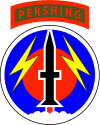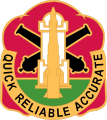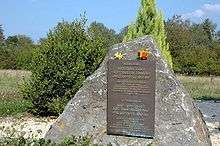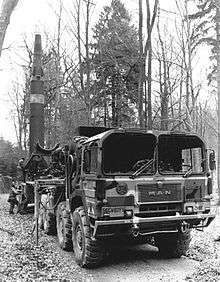56th Field Artillery Command
| 56th Field Artillery Command | |
|---|---|
|
56th Field Artillery Command shoulder sleeve insignia 1971–91 | |
| Active |
|
| Country | United States |
| Branch | United States Army |
| Motto(s) | "Quick, Reliable, Accurate" |
| Equipment | Pershing missile (1963–1991) |
| Engagements |
|
| Decorations |
|
The 56th Field Artillery Command was a brigade size element of the United States Army. The unit was constituted in 1942 with the last period of active service being 1963 through 1991 with the nuclear Pershing missile system.
Heraldry
Shoulder sleeve insignia

.svg.png)

The shoulder sleeve insignia was authorized for wear by all subordinate units.
Description: On a disc 3 inches (76 mm) in diameter, with a 1⁄8 inch (3 mm) white border a scarlet disc centered on a blue background and surmounted at center by a vertical black missile silhouette outlined in white and issuing to base a white-edged scarlet flame and white smoke cloud, the missile flanked by two diagonal yellow lightning flashes issuing from either side of the nose cone. Attached immediately above the disc, an arc tab 2 3⁄8 inches (60 mm) in length and 11⁄16 inch (17 mm) in height consisting of a dark green background inscribed "Pershing" in scarlet letters 5⁄16 inch (8 mm) in height, with a 1⁄8 inch (3 mm) scarlet border.
Symbolism: Scarlet and gold (yellow) are the colors used for field artillery; blue denotes the assigned infantry support. The destructive power and target capability of the Pershing missile are suggested by the red disc at center and the upright missile signifies the readiness of the unit. The lightning flashes refer to the ability of the missile team to act and strike quickly in event of need.
Background: The shoulder sleeve insignia was originally approved for the 56th Artillery Brigade on 9 June 1971 The Pershing tab was authorized for wear effective 18 September 1970. It was redesignated for the 56th Field Artillery Brigade on 7 April 1972. The insignia was redesignated effective 17 January 1986 for the 56th Field Artillery Command.[3]
Previous insignia: From 1963 to 1970, the authorized shoulder sleeve insignia was the emblem of the Seventh United States Army. From 1970 to 1971, the Pershing tab was worn with the Seventh Army insignia.
Distinctive unit insignia

.png)
The distinctive unit insignia was authorized only for Headquarters and Headquarters Battery (HHB).
Description: A gold color metal and enamel device 1 3⁄16 inches (30 mm) in height overall consisting of a scarlet background with a trilobated cloud at the top bearing two black crossed cannons behind a white domed tower with black archway, (as depicted on the coat of arms of the city of Antwerp, Belgium) on a green base, surmounted overall by a vertical gold Pershing missile; all above a semi-circular gold scroll inscribed "Quick Reliable Accurate" in black letters.
Symbolism: Scarlet and yellow (gold) are the colors used for Field Artillery. The trilobated cloud symbolizes the Headquarters and Headquarters Battery, 56th Field Artillery Brigade's Northern France, Central Europe and Rhineland Campaigns during World War II. The crossed cannons with the Antwerp Tower allude to the Headquarters Battery's two Belgian Army Order of the Day Citations, the Belgian Fourragere for action at Antwerp and the Defense of Antwerp Harbor. Red and green are the colors of the Belgian Fourragere. The Pershing missile alludes to the unique mission of the unit as a participant in the Army's first nuclear strike force with missiles on constant alert (QRA).
Background: The distinctive unit insignia was originally approved for the 56th Field Artillery Brigade on 11 April 1972. It was redesignated effective 17 January 1986 for the 56th Field Artillery Command.[3]
Note: The older DUI was worn from 1967 to 1972.
History
1942–1945
The 56th Coast Artillery Brigade was constituted on the Inactive list, 14 September 1942. It was activated at Camp Stewart, Georgia on 10 April 1943 and was redesignated the 56th Antiaircraft Artillery Brigade on 28 May 1943.[4] During World War II, Headquarters Battery (HHB) saw action in Belgium and received two Belgian Fourrageres for action at Antwerp and was cited for the defense of Antwerp Harbor. HHB is entitled to permanently display the Belgian Fourragere from the spearhead of its guidon.[2] In 1945, the unit was inactivated at Camp Shanks, New York.
1951–1961
In 1951, the 56th Antiaircraft Artillery Brigade was reactivated at Camp Edwards, Massachusetts and assigned to the United States First Army.[5][6] On 5 November 1951 The 56th AAA Brigade transferred from Camp Edwards to Fort Devens, Massachusetts and was assigned to the Eastern Army Antiaircraft Command.[7][8] They were then transferred to Fort Totten, New York on 24 January 1953.[9] The unit transferred back to Fort Devens on 15 July 1956.[10] They were redesignated as the 56th Air Defense Artillery Brigade on 20 March 1958.[11] The 56th Artillery Brigade was inactivated on 24 December 1964.[12]
Moved to Coventry, Rhode Island, Oct 1964. Initially the unit controlled the 11th Artillery Group (Rhode Island) and 15th Group (Massachusetts). Starting in June 1961, the battalions were directly under the brigade. The brigade was inactivated upon move of 24th Arty Group to Coventry in Dec 64.
HHB, 11th AAA Group (Continental) was redesignated as HHB, 11th Artillery Group (Air Defense) on 20 March 1958. Transferred from Fort Jackson, SC, to Rehoboth, Massachusetts, 15 May 58. Controlled 4th Battalion, 56th Artillery and 4-68 Arty at Providence, RI. Inactivated at Rehoboth, 25 Sep 60.
The 15th AAA Group (Continental) was activated at Ft. Banks, 13 Jul 52. Redesignated as the 15th Artillery Group (Air Defense), 20 Mar 58. Moved to Quincy, Massachusetts, 7 Aug 58. Controlled Boston [3-5 Arty, 3-52 Arty, 1-57 Arty] air defense units under 56th Brigade. Inactivated at Quincy, 24 June 1961.
1963–1991

56th Artillery
In April 1963, the 56th Artillery Group was activated in Schwäbisch Gmünd, West Germany commanded by Col. Douglas C. France, Jr. The group prepared for the deployment of the new weapons system, the Pershing 1 nuclear missile. Headquarters & Headquarters Battery (HHB) was initially stationed at Hardt Kaserne (formerly Adolf Hitler Kaserne) and moved to Bismarck Kaserne in November 1968.
The 56th Artillery Group was redesignated as the 56th Artillery Brigade on 17 August 1970. The brigade was authorized an increased level in command positions in the firing units. Platoon leaders were captains, battery commanders were majors, battalion commanders were lieutenant colonels and the brigade commander was a colonel.
With the split of the Artillery Branch into Field Artillery and Air Defense Artillery, the brigade was redesignated as the 56th Field Artillery Brigade on 15 March 1972.
In 1965 the 56th Artillery Group assumed the critical role of a quick reaction alert (QRA) force and was required to maintain a portion of each unit at the highest level of combat readiness. These portions were to react within seconds of verified orders, and the entire command was to be fully operational within 2 hours of any alert activation. The increased requirements of the QRA mission necessitated some modifications to upgrade the Pershing missile system and at the same time caused the Army to increase the number of launchers at each battalion from four to 36.
The newly designated brigade was to command 1st Battalion, 41st Field Artillery Regiment, 1st Battalion, 81st Field Artillery Regiment and 3rd Battalion, 84th Field Artillery Regiment as Pershing firing battalions. Also subordinate to the brigade was 2nd Battalion, 4th Infantry Regiment, tasked to provide defensive support to the firing units according to their security needs. A host of additional units provided support from medical to logistical, ensuring the brigade's ability to operate.
In November 1983, with the Soviets fully invested in the SS-20, and on the verge of bankruptcy, the Americans began fielding the Pershing II. By 1985 all three firing battalions were completely operational with Pershing II and the Soviet Union faced a threat they were financially unwilling to counter.[13]

On 11 January 1985 three soldiers, SSG John Leach, SGT Todd A. Zephier, and PFC Darryl L. Shirley of Battery C, 3rd Battalion, 84th Field Artillery were killed in an explosion at Camp Redleg, Heilbronn. The explosion occurred while removing a missile stage from the storage container during an assembly operation. An investigation revealed that the Kevlar rocket bottle had accumulated a triboelectric charge in the cold dry weather; as the engine was removed from the container the electrical charge began to flow and created a hot spot that ignited the propellant.[14][15] A moratorium on missile movement was enacted through late 1986 when new grounding and handling procedures were put into place.
In January 1986, there was a major reorganization; the 56th Field Artillery Brigade redesignated as the 56th Field Artillery Command and authorized a major general as a commander. 1st Battalion, 81st Field Artillery inactivated and reformed as 1st Battalion, 9th Field Artillery in Neu-Ulm, 1st Battalion, 41st Field Artillery inactivated and reformed as 2nd Battalion, 9th Field Artillery in Schwäbisch-Gmünd and 3rd Battalion, 84th Field Artillery inactivated and reformed as 4th Battalion, 9th Field Artillery in Heilbronn. With 3rd Battalion, 9th Field Artillery at Fort Sill, all the firing units were then under the 9th Field Artillery Regiment. The 55th Maintenance Battalion redesignated as 55th Support Battalion and E Company, 55th Maintenance Battalion deactivated and reformed as the 193rd Aviation Company. [16] With 3rd Battalion, 9th Field Artillery at Fort Sill, all of the firing units were then under the 9th Field Artillery Regiment. The 55th Maintenance Battalion was redesignated as 55th Support Battalion and E Company was reformed as the 193rd Aviation Company. The communications assets at each battery, were removed and consolidated into the 38th Signal Battalion.
The 56th Field Artillery Command was organized to always report directly to the highest commander in Europe at the time. Therefore during peacetime, they reported to the United States Army Europe, whereas, during heightened tension or war, command passed to NATO, with Allied Air Forces Central Europe as the next higher headquarters.[17]
Additionally, command levels for the field artillery batteries were increased by one grade over similar units. Platoons were commanded by a captain, and batteries by a major. Battalions continued to follow a lieutenant colonel while the command itself was led by a brigadier general and later a major general.
These actions were meant to mitigate the increased responsibilities inherent with the mission they bore.
The Intermediate-Range Nuclear Forces Treaty[18] was ratified on 27 May 1988.[19] The firing batteries began to draw down their equipment as the missile launchers were destroyed. The Pershing first- and second-stage motors, reentry vehicles, warhead and radar section airframes were returned to Pueblo Depot Activity for elimination. On 30 June 1991, the 56th FA was inactivated,[20] and the final entry for this command's history shows them as "discontinued" on 30 September 1991.[21]
Commanders
- April 1963: Col. Douglas Carter France, Jr.
- August 1965: Col. Rex H. Hampton, Sr.
- 15 July 1967: Col. Patrick William Powers
- November 1968: Col. James Edward Convey, Jr.
- September 1970: Lt. Col. Patrick William Powers; promoted to Brig. Gen.
- December 1972: Brig. Gen. Tom Judson Perkins
- 1973: Col Richard Donald Boyle
- 1973: Brig. Gen. Milton Eugene Key
- January 1975: Brig. Gen. Robert B. Hankins
- 1978: Col Richard Donald Boyle; promoted to Brig. Gen.
- 1980: Col. Sidney Davis; promoted to Brig. Gen.
- 1982: Brig. Gen. William Earl Sweet
- 1984: Brig. Gen. Raymond E. Haddock; promoted to Maj. Gen. 4 August 1987
- 1987: Brig. Gen. Roger K. Bean; promoted to Maj. Gen. 24 August 1989
4th Missile Battalion, 41st Artillery Regiment
The 4th Missile Battalion, 41st Artillery Regiment was activated on 14 January 1963 per General Order 428 at Fort Sill, Oklahoma with four Pershing 1 missiles. Lt. Col. Fitzpatrick took command on 21 July 1963. The battalion began training and completed live fires at Fort Wingate, New Mexico. The battalion and equipment shipped aboard the USAT General Simon B. Buckner on 3 April 1964 bound for West Germany. The unit deployed to Schwäbisch Gmünd under the 56th Artillery Group and was garrisoned on Hardt and Bismark Kasernes. The battalion increased to six launchers in 1964 and to eight launchers in 1965. The battalion exchanged the Pershing 1 missiles for 36 Pershing 1a missiles in 1969.
The battalion was deactivated on 29 September 1972 by General Order 1033 and reactivated as the 1st Battalion, 41st Field Artillery Regiment.
Commanders
- 21 July 1963: Lt. Col. Fitzpatrick
- July 1965: Lt. Col. LTC Milton Leland Haskin
- July 1967: Lt. Col. William H. Goodwin
- July 1969: Thomas E. de Sharo
- Lt. Col. Bush
- 1972: Lt. Col. Larry H. Hunt
1st Battalion, 41st Field Artillery Regiment
1st Battalion, 41st Field Artillery was activated on 29 September 1972 in Schwäbisch Gmünd, West Germany. Service Battery was deactivated and reformed as A Company, 55th Maintenance Battalion in 1982. The battalion exchanged the Pershing 1a missiles for Pershing II missiles in 1984. The battalion was inactivated in 1986 and reformed as the 2nd Battalion, 9th Field Artillery Regiment.
Commanders
- 1972: Lt. Col. Larry H. Hunt
- December 1973: Lt. Col. Raymond E. Haddock
- June 1975: Lt. Col. Stan King
- December 1976: Lt. Col. Fred Pope
- 1978: Lt. Col. Gerald R. Lauzon
- 24 June 1980: Lt. Col. Myron F. Curtis
- 2 July 1983: Lt. Col. Doug Middleton
1st Battalion, 81st Field Artillery Regiment
The 1st Missile Battalion, 81st Artillery was formed at Fort Sill in 1963 and deployed to McCully Barracks in Wackernheim, West Germany under the 56th Field Artillery Group. The battalion moved to Wiley Barracks, Neu-Ulm in 1968 and was redesignated the 1st Battalion, 81st Field Artillery Regiment effective 1 September 1971. It was initially equipped with eight Pershing 1 missiles and in 1969 replaced these with 36 Pershing 1a missiles. Service Battery was deactivated and reformed as B Company, 55th Maintenance Battalion in 1982. The battalion exchanged the Pershing 1a missiles for Pershing II missiles in 1984. The battalion was inactivated in 1986 and reformed as the 1st Battalion, 9th Field Artillery Regiment.
3rd Battalion, 84th Field Artillery Regiment
The 3rd Missile Battalion, 84th Artillery Regiment was formed at Fort Sill in 1963 and deployed to Heilbronn, West Germany under the 56th Field Artillery Group. It was initially equipped with four Pershing 1 nuclear missiles, upgraded to six in 1964 and eight in 1965 and in 1969 replaced these with 36 Pershing 1a missiles. The battalion was redesignated as the 3rd Battalion, 84th Field Artillery Regiment in 1968. Service Battery was deactivated and reformed as C Company, 55th Maintenance Battalion in 1982. The battalion exchanged the Pershing 1a missiles for Pershing II missiles in 1984. The battalion was inactivated in 1986 and reformed as the 4th Battalion, 9th Field Artillery Regiment.
2nd Battalion, 4th Infantry Regiment
2nd Battle Group was redesignated the 2nd Battalion, 4th Infantry Regiment on 21 July 1969 and activated at Fort Campbell, Kentucky. On 18 September 1970 the battalion was assigned to the 56th Field Artillery Brigade headquartered in Schwäbisch Gmünd, West Germany.
Headquarters and Headquarters Company (HHC) and A Company were garrisoned at Flak Kaserne in Ludwigsburg. B Company was at Nelson Barracks in Neu-Ulm and C Company was at Artillery Kaserne in Heilbronn. HHC moved to Nelson Barracks in Neu-Ulm in 1971. A Company moved to Wilkins Barracks in Kornwestheim, then to Nelson Barracks in Neu-Ulm in 1986. C Company moved to Wharton Barracks in Heilbronn in 1971. By 1974 HHC was at Wilkins Barracks in Kornwestheim, as was battalion headquarters.
The unit defended the missile battalions from intruding protesters, from the Nationalist Green Party and other elements. The mission of the 2nd Battalion, 4th Infantry was to provide armed security including patrols of the Pershing nuclear missile and missile storage sites—Muetlangen was the Missile Storage Site; Inneringen (Company A), Von Steuben (Company B), and Red Leg (Company C) were the 3 Combat Alert Sites (CAS) additional duties included protecting Pershing nuclear systems in the field and dealing with numerous anti-nuclear protests. It also pursued a rigorous infantry training schedule. Initially, HHC (Hurons) and Company A (Apaches or Alpha) were stationed at Wilkin Barracks in Kornwestheim, outside of Stuttgart; Company B (Blackfeet) was stationed at Nelson Kaserne in Neu Ulm; and, Company C (Cherokees) was stationed at Wharton Barracks in Heilbronn. HHC was later at Nelson Kaserne in Neu Ulm.
The 2d Battalion, 4th Infantry participated in major exercises each winter at training areas such as Baumholder, Hohenfels Hohenfels, Wildflecken, and Grafenwoehr. This helped to prepare the unit for encounters with Warsaw Pact military forces in the event of an assault on the missile sites. This was considered a very real possibility during the years of the Cold War. In addition each of the line companies rotated each year to Doughboy City, Berlin to train in military operations in an urban terrain (MOUT).
On 18 August 1971, soldiers from the heavy mortar platoon from battalion headquarters were being transported from Ludwigsburg to Grafenwoehr for live fire training exercises aboard a CH-47A helicopter. The helicopter crashed and exploded, killing all 38 on board, including four members of the 4th Aviation Company.
On 17 January 1986 the battalion was withdrawn from the Combat Arms Regimental System and reorganized under the United States Army Regimental System.
The signing of the Intermediate Nuclear Forces (INF) Treaty (1987), the fall of the Berlin Wall 1989, and the demise of the Soviet Union (1991) signaled the end of the Cold War and resulted in the eventual inactivation of the 2nd Battalion, 4th Infantry. On 15 May 1991, the 56th Field Artillery Command and all its subordinate units were inactivated.
266th Chemical Detachment
The 266th Chemical Detachment was activated as part of the 56th Field Artillery Brigade on 13 September 1972. The detachment was attached to Headquarters and Headquarters Battery, 56th Field Artillery Brigade and was garrisoned at Bismark Kaserne in Schwäbisch Gmünd.
55th Support Battalion
The 55th Maintenance Battalion activated as part of the 56th Field Artillery Brigade in 1982. The 579th Ordnance Company deactivated and reformed as Headquarters Company and D Company. The three service batteries in the field artillery battalions deactivated and reformed as forward service companies A, B and C under the 55th.[22] The aviation sections of each field artillery battalion reorganized as E Company.
38th Signal Battalion
193rd Aviation Company
Under the January 1986 reorganization, E Company, 55th Maintenance Battalion was deactivated and reformed as the 193rd Aviation Company at Cooke Barracks in Göppingen. The unit operated thirteen Bell UH-1 Iroquois helicopters. In June 1988, UH-1H airframe number 68-15387 of the 193rd struck a power line during low visibility conditions and crashed near Hittistetten, Senden, West Germany, killing three soldiers.[23][24]
Decorations
In 1968 the group created the Pershing Professionals Badge to recognize individual proficiency on the Pershing missile system. It was awarded through 1979.
The Superior Unit Award was presented to the 56th Field Artillery Command and its subordinate units for service during the Pershing II fielding, 1 November 1983 through 31 December 1986.[25][26]
Subordinate units
April 1963
- Headquarters and Headquarters Battery (HHB)
- 4th Battalion, 41st Field Artillery Regiment
- 1st Battalion, 81st Field Artillery Regiment
- 3rd Battalion, 84th Field Artillery Regiment
18 September 1970
- Headquarters and Headquarters Battery (HHB)
- 4th Battalion, 41st Field Artillery Regiment
- 1st Battalion, 81st Field Artillery Regiment
- 3rd Battalion, 84th Field Artillery Regiment
- 2nd Battalion, 4th Infantry Regiment
29 September 1972
- Headquarters and Headquarters Battery (HHB)
- 266th Chemical Detachment
- 1st Battalion, 41st Field Artillery Regiment
- 1st Battalion, 81st Field Artillery Regiment
- 3rd Battalion, 84th Field Artillery Regiment
- 2nd Battalion, 4th Infantry Regiment

1982
- Headquarters and Headquarters Battery (HHB)
- 266th Chemical Detachment
- 1st Battalion, 41st Field Artillery Regiment
- 1st Battalion, 81st Field Artillery Regiment
- 3rd Battalion, 84th Field Artillery Regiment
- 2nd Battalion, 4th Infantry Regiment
- 55th Maintenance Battalion
17 January 1986 through 31 May 1991[27]
- Headquarters and Headquarters Battery (HHB)
- 266th Chemical Detachment
- 1st Battalion, 9th Field Artillery Regiment
- 2nd Battalion, 9th Field Artillery Regiment
- 4th Battalion, 9th Field Artillery Regiment
- 2nd Battalion, 4th Infantry Regiment
- 55th Support Battalion
- 193rd Aviation Company
- 38th Signal Battalion
References
- ↑ History Card 1991, General Orders 24. Department of the Army. 10 December 1947.
- 1 2 History Card 1991, General Orders 43. Department of the Army. 19 December 1950.
- 1 2 "56th Field Artillery Command". United States Army Institute of Heraldry.
- ↑ History Card 1991, General Orders 51. Department of the Army. 31 May 1943.
- ↑ History Card 1991, AGAO-I 322. Gen Res. 21 January 1951.
- ↑ History Card 1991, General Orders 73. HQ, First Army. 31 May 1951.
- ↑ History Card 1991, MO #95. HQ, First Army, AHFKC(S) 370.5. 27 September 1951.
- ↑ History Card 1991, General Orders 27. HQ, Eastern Army Antiaircraft Command. 5 November 1951.
- ↑ History Card 1991, General Orders 95. First Army. 22 July 1953.
- ↑ History Card 1991, General Orders 52. First Army. 19 July 1956.
- ↑ History Card 1991, General Orders 36. First US Army. 28 March 1958.
- ↑ History Card 1991, General Orders 229. US Army Air Defense Command. 23 December 1964.
- ↑ "The Cold War Museum".
- ↑ Knaur, James A. (August 1986). "Technical Investigation of 11 January 1985: Pershing II Motor Fire" (PDF). Defense Technical Information Center.
- ↑ Davenas, Alain; Rat, Roger (July–August 2002). "Sensitivity of Solid Rocket Motors to Electrostatic Discharge: History and Futures" (PDF). Journal of Propulsion and Power. 18 (4).
- ↑ "Army Superior Unit Award" (PDF). US Army. 30 December 1992: 10. General Orders 34.
- ↑ "Pershing Keeps Soviet Bear at Bay". The Pershing Cable. 56th Field Artillery Command. 1986–1987.
- ↑ "Treaty Between the United States of America and the Union of Soviet Socialist Republics on the Elimination of Their Intermediate-range and Shorter-range Missiles (INF Treaty)". United States Department of State. 8 December 1987.
- ↑ "The Pershing Weapon System and Its Elimination". United States Army.
- ↑ History Card 1991, PO 132-8. USAREUR and Seventh Army. 21 September 1990.
- ↑ History Card 1991, PO 147-6. USAREUR and Seventh Army. 17 October 1990.
- ↑ "55th Maintenance Battalion". Donau. U.S. Army. 16 July 1982.
- ↑ "The World". Los Angeles Times. 10 June 1988.
- ↑ "Huey Crewmembers Line of Duty Deaths". Army Air Crews. 12 December 2014.
- ↑ "Army Superior Unit Award" (PDF). Department of the Army. 1 April 1987. General Orders 9.
- ↑ "Army Superior Unit Award" (PDF). Department of the Army. 1 July 1987. General Orders Number 30.
- ↑ "Plotting Pershing on the Map". The Pershing Cable. 56th Field Artillery Command. 1986–1987.
Bibliography
- History Card, 56th Coast Artillery, 56th Coast Artillery Brigade, 56th Antiaircraft Artillery Brigade, 56th Artillery Brigade, 56th Field Artillery Brigade, 56th Field Artillery Command. United States Army. 30 September 1991. WD AGO Form 016.
- Lineage and Honors: Headquarters and Headquarters Battery, 56th Field Artillery Command. Department of the Army.